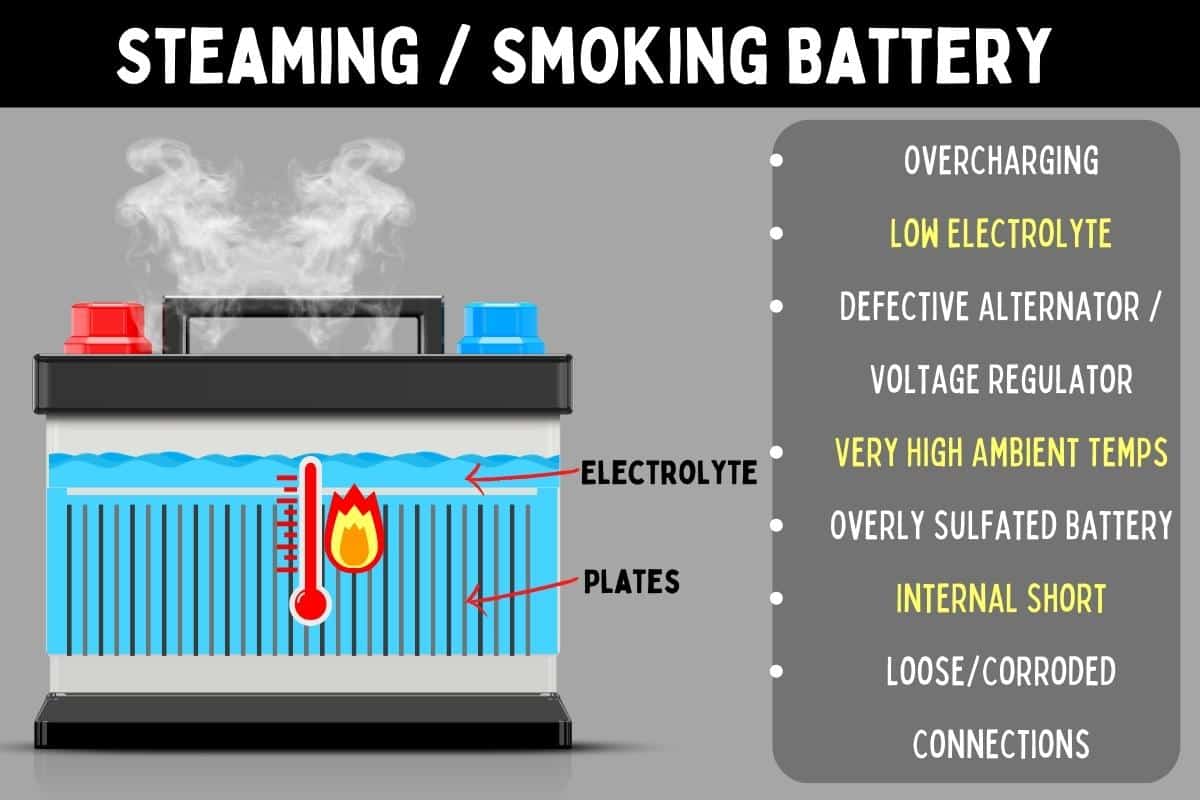Listen to the article below by hitting the play button below and feel free to scroll the page for any helpful visuals. All of the articles on this website will have this audio feature for your convenience.
Seeing smoke (usually steam) rise up from your battery is a terrifying sight and is a clear indicator that something isn’t right. If you continue to use a battery that is exhibiting these signs, then you will likely be heading towards a completely useless battery, a fire, or even an explosion.
The following table will give you the cause, the reason, and the fix for the 7 most common problems when it comes to your smoking car battery.
| Reason for Smoking Battery | Cause | How to Fix |
|---|---|---|
| Overcharging | Battery is either full and still being fed a charge that it can no longer accept, or an over-sized battery charger is being used and the battery cannot convert the current to stored chemical energy fast enough. Battery will get rid of the excess current as heat which will boil off the electrolyte and create steam. | Use a properly sized smart charger by keeping the charging amps at 10% or less of the total Ah (ampere hour) rating on the battery |
| Low Electrolyte (Flooded Batteries Only) | Low electrolyte will expose the plates in the battery cells to air and heavily sulfate them, which is a crystal buildup that inhibits charging and discharging. This increases internal resistance and excess heat is generated which boils off even more electrolyte and you see the steam rising from the battery. | Ideally, add just enough distilled water to cover the plates and then charge your battery with a properly sized smart charger. When complete, add more distilled water until you’re just below the fill tubes. |
| Alternator / Voltage Regulator Malfunctioning | A malfunctioning alternator or voltage regulator (either electric or computerized) can cause a battery to undercharge or overcharge. If it overcharges, then the excess current will be released as heat which will boil off your electrolyte into visible steam. | Have a mechanic inspect these if you’ve ruled out other issues. Often times, this problem will also be accompanied by the battery light on your dash lighting up, engine stalling, and issues with your lights. |
| Very High Ambient Temperatures | High electrolyte temperatures cause a battery to both discharge and charge faster — often faster than the battery can structurally handle. The normal charge from an alternator in 70°F (21°C) weather might be fine but at 105°F (40.5°C) that same charging current and voltage could be considered “overcharging” which will boil off electrolyte into visible steam. Newer vehicles have alternators and voltage regulators that should take ambient temperature into account and adjust charging voltages accordingly. | Consider purchasing an AGM (Absorbed Glass Mat) battery instead of a flooded lead acid battery, as they are better suited for higher temperatures. ** A lead acid battery steaming or smoking in the heat is often associated with one or more conditions on this table as well, since the battery is often compromised to begin with. ** |
| Overly-Sulfated Battery | If a battery has had low electrolyte or if it has been left at 80% state of charge or lower for some time, then the plates will build up lead sulfate crystals which inhibit charging and discharging of the battery. This coating on the plates increases internal resistance and generates heat during charging and discharging and can boil off the electrolyte into visible steam. | Ensure electrolyte levels are where they need to be and use a charger that has a desulfation mode to dislodge as much of the lead sulfate crystals as possible. In the future, minimize taking short trips without using a battery charger as the alternator doesn’t have time to charge your battery after it works hard to start the engine. Replacing the battery may be necessary, as the sulfation usually gets too bad in 5-7 years under normal use anyway. |
| Internal Short | The battery may have experienced “shock damage” from a sudden jolt and had a weld or conductive internal piece break off and wedge itself between the plates, or lead sulfate deposits may have grown enough over time and bridged the gap between two plates. Either way, your battery is now shorting itself out internally very rapidly and won’t hold a charge. Rapid discharge like this will build up lots of heat and boil off your electrolyte into visible steam. | Unfortunately, replacing the battery is the only course of action. |
| Loose Connections / Terminal Corrosion | Loose connections at the battery terminals or corrosion on the terminals (sometimes not visible until the cable is removed) will cause arcing and will also build up lots of resistance and heat. Typically, this just results in a very hot terminal and cables, but it’s possible that the heat can extend into the battery itself and boil off the electrolyte into visible steam. | Remove cables and check for corrosion. Clean corrosion with a paste of baking soda and water, and then wipe clean. Dielectric grease may be used on the terminal posts before reattaching the cables. Tighten cables properly and ensure afterward by hand that they are tight. |
What is the Smoke Coming from My Car Battery?
Generally, the visual smoke coming from the battery is actually steam from the electrolyte boiling inside some or all of the battery’s cells. The electrolyte in the battery comprises water and sulfuric acid. If the battery is overcharged, has an internal short, or has too much internal resistance, then there is a good chance that the heat generated from these incidents will be high enough to boil out the electrolyte into visible steam.
The steam is generally accompanied by the sound of a liquid in a rolling boil, and you may also hear hissing or whistling as the high pressure steam is escaping the battery vents.
A battery can certainly have smoke coming from the case, and this is usually due to thermal runaway (caused by a large direct short like a metal wrench being left on the battery that touches both terminals, for example) or by having a loose or corroded connection at the terminals. In the case of the loose connection, the resistance and arcing that occurs can start to melt the plastic casing around the terminals due to the heat.

Is the Smoke from My Battery Dangerous?
Inhaling the steam from the electrolyte or the burning plastic from the battery case are both dangerous for your lungs. There are many toxic chemicals that are released in both the steam and smoke. Hydrogen sulfide gas, hydrogen, and water vapor are just some of the things you could breathe in.
Some of the gasses, like hydrogen and hydrogen sulfide are also dangerous in that they are easily ignited by a spark if their concentrations are high enough. Generally speaking, this will only happen within a few inches of the battery itself.
Always wear safety glasses when dealing with a battery and when giving a jump to a dead battery from another vehicle, always make sure to connect your negative jumper cable to the chassis of the vehicle (which is attached to the negative terminal of the battery anyway) so that when a spark occurs it will happen away from the battery and prevent an explosion.
